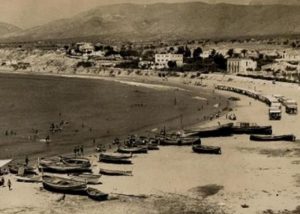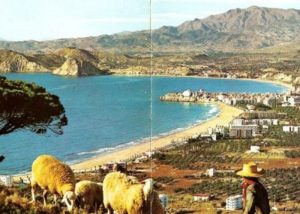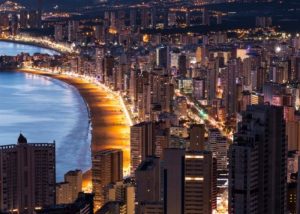BENIDORM – For many, Benidorm is a symbol of cheap mass tourism. Or of grey heads, burned red under a pleasant winter sun strolling along wide boulevards below towering buildings. But for Pedro Zaragoza, it was a land of opportunity!

More than 300 real skyscrapers (in Europe only Frankfurt and London have more) point jauntily into the azure blue sky. These help to ensure Benidorm has the most hotel beds in Europe after Paris and London.
Therefore, it is unimaginable that this mecca for the holidaying working class was built in just fifty years. However, one name is constantly mentioned to whom the credit belongs having laid the foundations for present-day Benidorm. That name is Pedro Zaragoza Orts.
“Tourist Pull”
Thanks to this ex-mayor, Benidorm is a symbol of mass tourism on the Spanish coasts. From his visionary mind sprang all kinds of ideas that formed the basis for the drastic change from sleepy coastal hamlet to the ‘tourist pull’ that Benidorm is today. Pedro Zaragoza Orts (1922) was appointed mayor in 1950 against his will – democracy was hard to find in Spain at that time under Franco’s rule – for three months. He then remained for sixteen years and has since been the most popular ex-mayor and icon for Spain’s tourism industry.
Vision

So the question Zaragoza asked himself was what ingredients the city had to offer for positive development. He always liked to hear the stories the sailors brought home after long journeys to unknown places. So, those stories, together with the summer visitors, gave Zaragoza the idea of developing tourism in his city. Benidorm didn’t have much to offer at the time. However, it did have a divine climate and two beautiful, wide, golden sand beaches.
Bikini

Tall, blond women were a new attraction on the beaches. Not least because of their very scarce costume: the bikini. A two-piece swimsuit that exposed a lot of skin. However, the bikinis of that time were very chaste compared to today’s pieces of fabric. Although, at that time in Spain, bikini was only permitted as long as the women lay flat on the beach. Furthermore, the first women who dared to walk the surrounding streets without dressing properly could count on a reprimand or even a fine from the Guardia Civil.
Pedro Zaragoza realised that this was not a very welcoming policy. After all, holidaymakers had to feel welcome and have so much fun in his city that they would return with all their friends and acquaintances in their wake. Under the guise of ‘why not also embrace the culture of the people who come from far away to visit Benidorm and spend their money here’, Zaragoza signed a municipal treaty that would allow the bikini. The Archbishop got wind of this and immediately threatened the progressive mayor with ex-communication.
Visit to Franco
To avoid being permanently banned from all public bodies, Zaragoza got up very early one cold morning. He tucked a few newspapers under his clothes for isolation, got on his Vespa, and drove to Madrid. After a nine-hour journey, he stood in front of El Pardo, the palace where Franco resided. To everyone’s surprise, his request for an audience with el Generalisimo was granted. Franco was able to sympathise with the small, energetic man who had crossed half the country on his moped. He gave his consent with the words ‘Wait a few days. And if you ever have a problem, come to me at once’.
Just over a week later, Franco’s wife Doña Carmen Polo de Franco, along with a minister and his wife, stood on Zaragoza´s doorstep. The group stayed for a week and a half and would return many more times. Benidorm had the scoop. The bikini conquered the streets forever and marked the beginning of a cautious sexual revolution in strict Catholic Spain. The archbishop and many other conservatives have taken Zaragoza seriously ever since.
Urban planning
Pedro Zaragoza didn’t just welcome the bikini. He also had a clear vision in other areas. His Plan de Ordenación de Benidorm of 1954 was revolutionary and completely focused on the future. He had forty metres wide avenues built in an even more undeveloped area of Benidorm. He also made the decision to build in height. His measure of new building land was volume rather than square metres. His argument: if you decide to build a building of a certain volume in height on a plot of land of a certain size, you will have space around the building for swimming pools, tennis courts, and parks.

Marketing
The first charter flight, packed with tourists to destination Southern Europe in the 1950s, was the start of the enormous impulse for Benidorm. Zaragoza responded very cleverly and managed to make Benidorm internationally known with many playful actions. He once invited an entire family from Lapland to his city and had people travel slowly south by bus in their own traditional costumes. The bus with destination Benidorm stopped everywhere and the family quickly became an attraction that received a lot of media attention.
Zaragoza also had boxes of turrón – a regional delicacy – and cases of wine with the text ‘produced under the sun of Benidorm’ sent to Queen Elizabeth of England. He also invited as many celebrities as possible to stay in the new holiday destination. Once he drove back to Spain from a holiday fair in Cologne in a Mercedes and single-handedly placed signs at strategic points along that route that read ‘Benidorm, xx kilometers to go’.
Together with two others, he was the initiator of the famous song festival of Benidorm that has 39 editions to date, has acquired international fame, and has given a major boost to the careers of stars such as Julio Iglesias. Every year Zaragoza provided performances by famous artists that attracted the attention of both national and international media.
Pedro Zaragoza
Years ago, Zaragoza was asked in an interview whether he was proud of Benidorm today, referring to the often negative image of the holiday resort. He admitted eloquently that Benidorm may not have become much more attractive than it used to be, but it has certainly become more liveable; with asphalt, running water, hospitals and electricity. Moreover: nobody is forced to visit Benidorm and yet every year more than five million visitors spread their towels on the beach for a few days.
In addition to being mayor for sixteen years, Pedro Zaragoza also became president of the Diputación de Alicante, general director for the Ministry of Information in Madrid, civil governor of Guadalajara, and a member of parliament. At the age of fifty, he started a new career as a lawyer. Meanwhile, he wrote five books and contributed to a large number of Spanish newspapers. At 85 he was still active in the legal profession, albeit at a slower pace, but still at the centre of the economic, social, and tourist phenomenon: Benidorm. Pedro Zaragoza died on April 1, 2008, from the effects of a heart problem.


